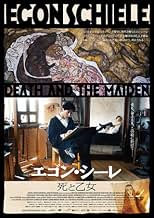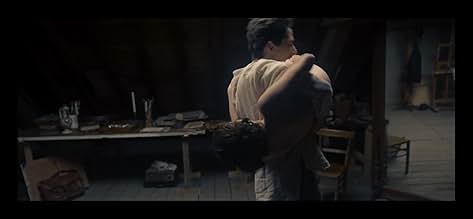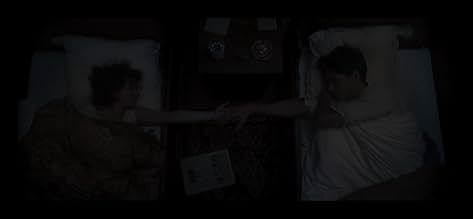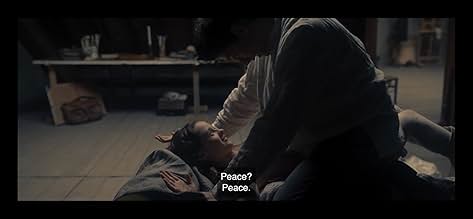AVALIAÇÃO DA IMDb
6,5/10
1,6 mil
SUA AVALIAÇÃO
Adicionar um enredo no seu idiomaVienna, early 20th century: the young Egon Schiele is one of the most discussed artists of his time with his original, erotically charged works.Vienna, early 20th century: the young Egon Schiele is one of the most discussed artists of his time with his original, erotically charged works.Vienna, early 20th century: the young Egon Schiele is one of the most discussed artists of his time with his original, erotically charged works.
- Direção
- Roteiristas
- Artistas
- Prêmios
- 7 vitórias e 10 indicações no total
Larissa Breidbach
- Moa Mandu
- (as Larissa Aimée Breidbach)
- …
Avaliações em destaque
Biopic of expressionist artist Egon Schiele. It's a little artsy (!) but all in all pretty good. What exquisite bodies the two females who play his main models are endowed with. The movie tells his story with a good flow; it makes me want to read up on his life.
It is always complicated to convey the essence of a great artist through cinema or TV.
This film is simple and delicate. The main actor is very intense and does a wonderful job in portraying Egon Schiele. All of the actors are very good, really. Unfortunately, their performances are not enough to elevate the film much above mediocrity. However, if the author fails to catch the true spirit of such an extraordinary and revolutionary genius, he succeeds in depicting the profound sense of melancholy and sadness, uncertainty and disenchantment that permeated Europe throughout First World War.
This film is simple and delicate. The main actor is very intense and does a wonderful job in portraying Egon Schiele. All of the actors are very good, really. Unfortunately, their performances are not enough to elevate the film much above mediocrity. However, if the author fails to catch the true spirit of such an extraordinary and revolutionary genius, he succeeds in depicting the profound sense of melancholy and sadness, uncertainty and disenchantment that permeated Europe throughout First World War.
Precise, powerful, delicate. Egon Schiele and the women of his life. Admirable performance of Noah Saavedra, flavors of Austria of Belle Epoque, wise use of biographic details. Could it be better ? Off course ! But, in the case of Schiele, it is difficult or too subjective to define this better. The film has the precious gift to be a correct one. A good invitation to discover the fascinating universe of the art of Egon Schiele. A sketch, maybe, but, obvious, an inspired one, reflecting care and science and admiration for the great artist. Not a story about a genius but portrait of an exceptional young man and his reflections of emotions in a special, profound special art. So, a beautiful sketch.
Despite being quite a popular and well established genre, biographical films about artists succeed quite seldom to become consistent works of art by themselves. In many cases they deal with personalities whose art and biographies are reasonably or well known to the audiences. The personalities of the artists, the environment they lived within, their relations with the society and the personal lives, in some cases controversial are good material, but the script writers, directors and actors have to match their cinematic work with the expectations, have to bring enough new elements to make the films interesting and above all have a formidable competitor for their films in the art created by the heroes of their stories. Austrian director Dieter Berner's tentative with "Egon Schiele: Death and the Maiden" (or "Egon Schiele: Tod und Mädchen" in German) is a good exemplification of a diligent tentative that does not succeed to avoid all the traps and surface above the crowd.
Egon Schiele was one of the lead artists in the period of art flourishing at the beginning of the 20th century in Austria. While post-Impressionism, Fauvism and Cubism was changing in a revolutionary manner the history of art in France, and while German artists were building the foundations of Expressionism and Abstract art, their Austrian colleagues of generation were shattering the bourgeois establishment with a more subtle and subversive approach. Certainly, the works of Klimt and Schiele were defining new aesthetic codes, but their attack on the conservative art was coming mostly on the moral grounds. In the decadent atmosphere of the end of the empire, they were living a free and amoral life according to the codes of their time, and this was reflected openly in their art. Egon Klimt, whose last eight years of his short life are described in the film, lived in a passionate but also deeply anxious manner. Had death not cut short his life (he died in the terrible flu epidemic in the last month of the war) he may have joined the expressionist current, and maybe become a great anti-war artist such as Otto Dix.
Unfortunately, little of the torments of the artist are translated to screen in "Egon Schiele: Death and the Maiden". We are served with a quite documented biographical film, which is as much as I can judge close and true to the facts that we know about his life. The focus of the script and of the film director was directed to the historical details and the sentimental life of the painter. There is too little in the film that can explain the psychological shock that one feels when looking at the paintings and drawings of Schiele, the deep mute shout that comes from the lines, the forms, the expressions of the people (mostly women) that he painted. The team of artists (Noah Saavedra, Maresi Riegner, Valerie Pachner) is very well selected, and their acting reveals a little more than the script does, but this is still enough. Director Dieter Berner succeeded to make a rather conventional film about a provoking artist.
Egon Schiele was one of the lead artists in the period of art flourishing at the beginning of the 20th century in Austria. While post-Impressionism, Fauvism and Cubism was changing in a revolutionary manner the history of art in France, and while German artists were building the foundations of Expressionism and Abstract art, their Austrian colleagues of generation were shattering the bourgeois establishment with a more subtle and subversive approach. Certainly, the works of Klimt and Schiele were defining new aesthetic codes, but their attack on the conservative art was coming mostly on the moral grounds. In the decadent atmosphere of the end of the empire, they were living a free and amoral life according to the codes of their time, and this was reflected openly in their art. Egon Klimt, whose last eight years of his short life are described in the film, lived in a passionate but also deeply anxious manner. Had death not cut short his life (he died in the terrible flu epidemic in the last month of the war) he may have joined the expressionist current, and maybe become a great anti-war artist such as Otto Dix.
Unfortunately, little of the torments of the artist are translated to screen in "Egon Schiele: Death and the Maiden". We are served with a quite documented biographical film, which is as much as I can judge close and true to the facts that we know about his life. The focus of the script and of the film director was directed to the historical details and the sentimental life of the painter. There is too little in the film that can explain the psychological shock that one feels when looking at the paintings and drawings of Schiele, the deep mute shout that comes from the lines, the forms, the expressions of the people (mostly women) that he painted. The team of artists (Noah Saavedra, Maresi Riegner, Valerie Pachner) is very well selected, and their acting reveals a little more than the script does, but this is still enough. Director Dieter Berner succeeded to make a rather conventional film about a provoking artist.
I've always been in love with Egon Schiele's work. He's probably my favourite painter. So, I was a bit skeptical about this film. But I loved it! The cinematography is beautiful, the performances are great (especially Noah Saavedra, Maresi Riegner, and Valerie Pachner), and the music is sublime. Egon produced in his short life around 300 canvases and around 2,000 water colours and drawings. And they are all amazing. I would have preferred a bit more about the paintings and less of the women, but overall, it's a wonderful film. Egon Schiele: Tod und Mädchen is a beautiful, erotic, sad, and poetic film. A real gem. 10/10.
Você sabia?
- CuriosidadesThe trailer for the movie was blocked on Facebook for the reason of nudity.
- Erros de gravaçãoDuring several closeups it can be seen that Noah Saavedra (Egon) and Valerie Pachner (Wally) are wearing contact lenses. The distinctive transparent rings around the irises are clearly showing.
- Citações
Egon Schiele: You can't buy art. Art is invaluable.
- ConexõesReferences Der Hirt von Maria Schnee (1920)
Principais escolhas
Faça login para avaliar e ver a lista de recomendações personalizadas
- How long is Egon Schiele: Death and the Maiden?Fornecido pela Alexa
Detalhes
- Data de lançamento
- Países de origem
- Centrais de atendimento oficiais
- Idioma
- Também conhecido como
- Egon Schiele: Death and the Maiden
- Locações de filme
- 101 Hietzinger Hauptstrasse, Vienna, Áustria(Schiele's Atelier exterior)
- Empresas de produção
- Consulte mais créditos da empresa na IMDbPro
Bilheteria
- Orçamento
- € 4.700.000 (estimativa)
- Faturamento bruto mundial
- US$ 598.929
- Tempo de duração1 hora 50 minutos
- Cor
- Proporção
- 2.35 : 1
Contribua para esta página
Sugerir uma alteração ou adicionar conteúdo ausente

Principal brecha
By what name was Egon Schiele: Tod und Mädchen (2016) officially released in Canada in English?
Responda

























